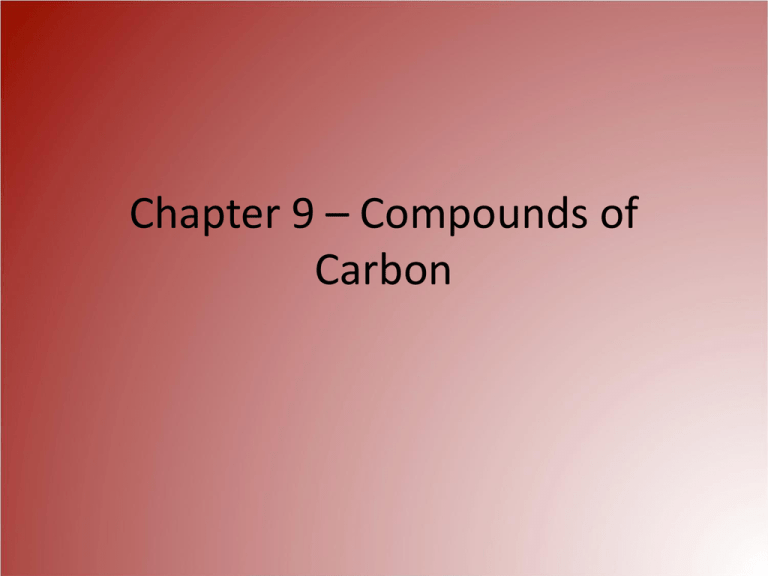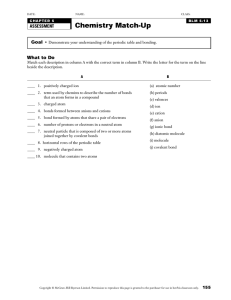Compounds of Carbon Powerpoint
advertisement

Chapter 9 – Compounds of Carbon Bonding in Carbon Compounds • Carbon’s electron configuration is 1s22s22p2. • It is in period 2, group 14 of the periodic table, meaning it has four outer electrons and is a small atom. • The carbon atom forms covalent bonds by sharing these electrons with other atoms. • Carbon forms strong covalent bonds with hydrogen atoms, and nearly all organic molecules contain hydrogen bonded to carbon. • Carbon also forms strong covalent bonds with other carbon atoms, forming long chains and rings. • Single, double or triple bonds can form between carbon atoms. Bonding in Carbon Compounds cont… • When four single bonds are formed around a carbon atom, the pairs of electrons in each bond act as a charge cloud. • These charge clouds repel each other, so that they spread out as far away from each other as possible. • This arrangement is called a tetrahedral arrangement. Homologous Series • Homologous series are where the compounds have similar structures and chemical properties and the same general formula. • Each member of a homologous series differs by a CH2 group from the previous member. Alkanes • Has the general formula of CnH2n+2. • The alkanes are called saturated hydrocarbons because they do not react further with hydrogen. • Only single carbon bonds are present. Cyclic Molecules • A chain of carbon atoms can also be bent round to form a ring. • Molecules formed in this way are called cyclic molecules. Cyclic Molecules cont… • Sometimes, like in the case of benzene, three of the four outer shell electrons from each carbon atom form normal covalent bonds but the fourth electron is shared (delocalised) around the six-membered carbon ring. • In all there are 6 delocalised electrons being shared by the six carbon atoms. • Compounds like this with rings of delocalised elecrons are known as arenes. a Benzene has delocalised electrons. b A shorthand representation of the benzene molecule. c The delocalised electrons are sometimes represented by these structures. Isomers • Molecules of alkanes that contain less than four carbon atoms, have only one possible structure. • Form butane onwards, there are different arrangements of atoms that share the same formula. • These are called structural isomers. • Structural isomers have different physical and chemical properties. Naming Alkanes • The first part of the name indicates the number of carbon atoms. • The last part ends in ane, to indicate there are only single bonds. • In isomers, the side chain can be considered as an alkane that has lost a hydrogen atom. • The fragment that forms the side chain is known as an alkyl group. Naming Isomers • The name of the longest alkane hydrocarbon chain. • The name and number of any alkyl side chains • The position of the side chain on the main carbon chain. Naming Isomers cont… • The systemic name usually contains a prefix, a stem and a suffix. • The name of the hydrocarbon can be determined as follows: 1. Identify the longest chain of carbon atoms. The carbon atoms in this chain are numbered. 2. Check bonding, ane for single bonds. 3. Identify the side chain and the number of the carbon atom on the longest chain to which it is attached. Numbering always starts on the end of the chain closest to a side chain. Alkenes • Hydrocarbons with double covalent bonds between carbon atoms are called alkenes. • The general formula of alkenes is CnH2n • Hydrocarbons that contain double or triple bonds are unsaturated hydrocarbons. • These substances are more reactive than alkanes. • The shape of the alkenes around the double bond is planar. • The angles around these bonds are 120 degrees. • Carbon atoms not involved in the double bond still have the tetrahedral orientations. Alkenes cont… • The names of alkenes end in ene. • The stem of the systematic name of alkenes is based on the longest chain that contains the double bond. • The position of the double bond is indicated by the number of the first carbon atom involved in the double bond.. • The rules for naming these chains are similar to those for alkanes. Functional Groups • Carbon can also form covalent bonds with other atoms or groups of atoms. • These are called functional groups. • A functional group is an atom or a group of atoms that gives a characteristic set of chemical properties to a molecule containing that group. • Many compounds can be produced by substituting a hydrogen atom in an alkane molecule with different functional groups. • The remaining fragment of the alkane, which has one hydrogen atom removed, is called an alkyl group, represented by R. Functional Groups cont… • The bonds formed between carbon atoms and between carbon and hydrogen atoms are strong and relatively unreactive. • Functional groups located in different positions in a molecule result in structural isomers. • Where needed, a number can be used to show where the functional group is attached to the carbon chain. Chloroalkanes • It is possible to replace a hydrogen atom in an alkane with a chlorine, to form a chloroalkanes. • The systematic name for a chloroalkane starts with chloro followed by the name of the alkane. • In chains higher than two carbons it is possible to put chlorines on different carbons. • In this case, numbers are used to indicate where the chlorine is. • The names of alkyl groups are also included in the name. • The other halogens fluorine, bromine and iodine form similar homologous series to the chloroalkanes. Name this chloroalkane… Alkanols • Alkanols is the systematic name for the group of chemicals commonly called alcohols. • Alkanols have the general formula of ROH. • The hydroxyl functional group –OH has been substituted for one hydrogen atom. • Alcohols are more soluble in water and have higher boiling points than alkanes. Alkanols cont… • Alkanols are named by dropping the e at the end and replacing it with ol. • In higher members of this series, the –OH functional group may be placed at the end or middle of the carbon chain. • Numbers are used to indicate the position of the functional group. Carboxylic Acids • Carboxylic acids contain the carboxyl functional group. • The general formula is RCOOH. • Bonds within this functional group are polarised, resulting in the formation of hydrogen bonds between molecules or between carboxylic acid molecules and water. • The stem of the systematic name of the carboxylic acids is determined by the number of carbon atoms in the longest chain that contains the COOH group. • The e is taken off the end, when naming, and replaced by oic. • Branched carboxylic acids are named in a similar way to the other branched organic compounds. Name this carboxylic acid… Amines • Organic compounds that contain the –NH2 functional group are called amines. • The general formula for the amine homologous series is RNH2. • These are named by replacing the e at the end of the name of the alkane with amine. • The bonds around the nitrogen atom are polar due to the high electronegativity of nitrogen. • Smaller amines are very soluble in water due to the formation of hydrogen bonds. • The solubility decreases as the size of the alkyl group becomes larger. Amino Acids • Are the basic building blocks for proteins. • The contain the amine and carboxylic acid functional groups.






